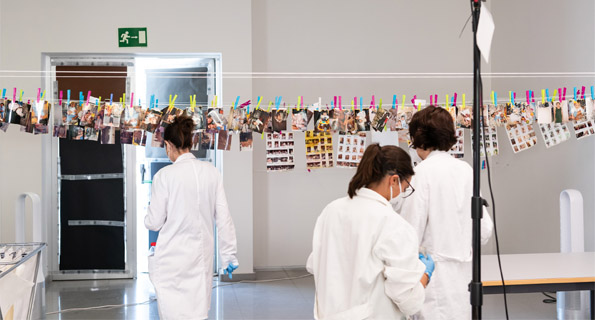Photographs saved from the mud
Conservation and Restoration students carry out an emergency intervention on albums recovered from the DANA in a field laboratory set up at the UPV
[ 15/11/2024 ]
Recovering the memory and the recollection of those who have lost almost everything is their goal. This drives them to dedicate ten hours each day to restoring photographs muddied by the effects of the DANA that occurred on October 29.
Around a hundred students and graduates from the Universitat Politècnica de València, mostly linked to the Conservation and Restoration of Cultural Heritage Department, participate in this project.
A group of students, faced with the disaster, asked the Academic Staff what they could do. The University decided to let a few days pass, prioritising the most important thing, the search for people, but on Monday, 4 November, they contacted the Dean of the Faculty of Fine Arts, José Galindo. Within two hours, they had set up a field laboratory and a space ready to receive the first photographs affected by the mud. And they immediately set to work, bucket in hand, to wash and hang these precious memories.
In many cases, it has been the volunteers who have participated in the cleaning tasks in the localities and who have taken the albums to the Politècnica. It has been the Bachelor's and Master's Degree in Conservation and Restoration of Cultural Heritage students and PhD Students who have been in charge of the handling of the images.
The process
Pilar Soriano, deputy director of the Conservation and Restoration of Cultural Heritage Department, explains the entire recovery process. First, the photographs are registered with a card that collects all the property details. If it is an album, an initial photograph of the closed album and its card is taken. Then, each page of the album is photographed to record the placement of the images.
Subsequently, each photo is then disassembled for cleaning. Although they should not get wet, in this case, as they come from a flood, they are washed by passing throug various tanks. The water is changed until it runs clear. They are hung with tweezers to dry them and mounted on special paper used in restoration in the same order as they were in the album.
“Before returning them, all the images are digitized, and the restored photos are then returned clean on paper along with the digitized ones on a USB drive, usually delivered by the same volunteer who brought them,” points out Pilar Soriano.
The five Valencian public universities
The project involves the five Valencian public universities under the umbrella of the Xarxa d'Universitats Públiques Valencianes per a la Cultura, together with the International Council of Museums (ICOM), the Spanish Conservation Group (GE-IIC) and the Museu Valencia d'Etnología (L'ETNO).
At the UPV, it is coordinated by Pilar Soriano, deputy director of the department, together with Esther Nebot, lecturer in Photography Restoration; Pedro Vicente, from the Drawing Department and director of the Master in Photography; and the collaboration of Ignacio Serrano, director of the Master's Degree in Digital Humanities.
Pilar Soriano recalls that the UPV has trained in restoration a litle over 30 years. It is the students and graduates who carry out the intervention of the photographs. A task that is completed with documentalists and historians from other universities.
Volunteer students participate in these recovery tasks wearing gloves and masks to protect themselves from fungus and viruses and the rancid smell accompanying the albums, which are irretrievable but not the photographs they contain. Full of memories of life and history.
Specialised assistance
Ainara Navarro Buceta, a second-year student of the Master's Degree in Conservation and Restoration of Cultural Heritage, talks about the "emotional wear and tear" she suffers with so much sadness. She is in the drying zone, and the sadness turns into satisfaction with each album recovered.
Jorge Ferrer Aparicio, a graduate in Conservation and Restoration of Cultural Heritage who has also been a volunteer cleaning up in the affected areas, says that recovering these memories "you feel the same as when you are there pulling out mud".
Marta García Gandia, also a second-year student of the Master's Degree in Conservation and Restoration of Cultural Heritage, is learning a lot. She is specialising in photographs damaged in a disaster. She is pleased "to be able to bring some happiness" to these people affected by the flood.
Paula Chico, a student with a Master's Degree in Conservation and Restoration of Cultural Heritage, "needed to help people in some way," and what better way to do it than with her university specialisation. In this way, she helps rescue the memory and brings some happiness back to those who have lost almost everything. With the past back in their hands, these photographs bring them a smile full of emotion. Historical memory remains, and photographs will remain an essential legacy for future generations.
Find out on dana.upv.es all the actions promoted by the UPV to respond to the catastrophe after the DANA
Carmen Revillo Rubio/ UPV Comunication Area (ACOM)
Outstanding news
 Study a degree at the best technological university in Spain
Study a degree at the best technological university in Spain
The Universitat Politècnica de València is ranked number 1 among Spanish technology universities, according to the Shanghai ranking
 National Research Award
National Research Award
Ramón Martínez Máñez has received the "Juan de la Cierva" National Research Award in the area of Knowledge Transfer
 The UPV and Beihang University strengthen their academic and scientific alliance
The UPV and Beihang University strengthen their academic and scientific alliance
The two universities have signed a new collaboration agreement as part of the celebration of "UPV Day" in China
 Study in English
Study in English
The UPV offers eight degrees, 16 master's and 650 courses in English for the 2025-26 academic year
 THE Impact Ranking
THE Impact Ranking
The UPV, the Spanish university with the greatest social and economic impact in the world






